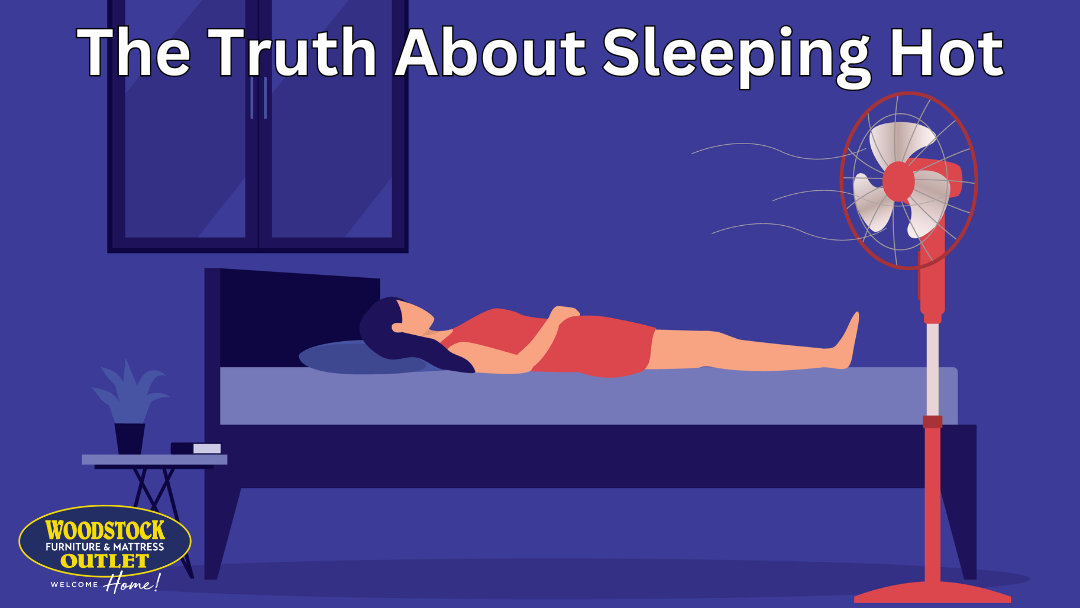When folks come to our furniture and mattress stores looking for a new mattress, we’ve noticed a number of recurring themes. In order to help shoppers find the just right mattress for them, there are a number of questions we ask to assess their unique sleep needs. During this process, inevitably the conversation turns to something many sleepers call sleeping hot.
Especially with couples, one of them almost always declares themself as the hot sleeper. If that’s you, you’ve likely asked this question many times in your life — “Why do I get so hot when I sleep?” When we hear customers admit to being hot sleepers, even the language they choose suggests that they believe themselves to be the problem. However, the available research on this topic strongly suggests another culprit.
Read on as we tackle the myth of hot sleepers. discover the real reason many of us get hot when we sleep, and learn what we can do about it!
The Hot Sleeper Myth
Go to sleep. Get too hot. Sweat profusely. Kick off the covers. Get freezing cold. Cover back up. Then start it all over again until your morning alarm wakes you from your disrupted, unsatisfying sleep. Does this miserable cycle sound familiar to you? If so, you’re not alone.

To be clear, when we talk about the myth of sleeping hot, we aren’t disputing that this problem exists. Quite the opposite! These issues are real and they can be devastating to your sleep quality and overall well-being when they happen. In fact, in our articles on the Science of Sleep, we discussed how sleeping hot can disturb critically important REM and deep sleep needed to repair your mind and body. Today, we’re merely disputing why these issues occur. And here’s a hint — it’s not you!
Now, it’s certainly true that different people (bedmates included) can have slightly different baseline body temperatures for a number of reasons. These may include differences in metabolic rates, age, activity level, or body fat percentage. And thanks to these variables, some folks do generally run a bit warmer than others. However, these differences are typically minuscule and can’t fully explain why some of us perceive nighttime temperatures so differently.
The truth is that the typical sleeper’s core temperature doesn’t increase overnight — it drops! Findings support that for most sleepers, core body temperatures drop somewhere between 1° and 3° Fahrenheit during the night, with body temps usually being their lowest after a couple hours of sleep.
Even if your body runs a smidge warmer than 98.6°F, how can you be a hot sleeper when your body is still several degrees cooler at night than during the day? Why do we feel so hot at night when we clearly aren’t? What else could it be?
“Why Do I Get So Hot When I Sleep?”
The myth is that some of us simply sleep hot and others don’t. But the truth is that what hot sleepers feel is happening, and what is actually happening are two very different things. For the vast majority of people, the reason we sleep hot has little to nothing to do with our body temperatures at all and everything to do with the microclimates we create in our beds and bedrooms.
Okay, but what the heck is a microclimate? Well, you, your mattress, your bedding, and your thermostat are all big parts of it. When we put on those flannel pajamas and fuzzy socks, and pile on the sheets, blankets, duvets and comforters, we inadvertently create a hot, humid microclimate caused by trapped body heat.
Over the course of the night, this heat build-up causes the mattress and bedding to heat up significantly. It’s at this point that we trigger the disruptive cycle we discussed above – getting overheated and sweaty, kicking off the covers, cooling too rapidly, and then covering back up. For most hot sleepers, this build-up and trapping of excess heat is the root cause of their sleep problems.
But don’t sweat it. Fortunately, there are a number of practical ways we can mitigate heat retention and the hot sleeping that results from it.
How To Fix Your Bedroom’s Microclimate
1) Check That Thermostat
First, it sounds pretty obvious, but you may need to experiment with your thermostat to find the best temperature for you. Did you know that many sleep experts recommend sleeping in a room between 60° and 68° Fahrenheit? If cranking up the air conditioning isn’t an option, make sure you’ve at least got a fan running to produce some airflow.
It goes without saying that if your bedroom is hot, you will be too. However, the same can be said if the temperature is too cold. If your sleeping environment is too cold, you’ll be tempted to pile on the layers – layers that will eventually need to be shed once you start to sweat and overheat.
2) Better Bedding Choices
Next, you need to take a closer look at the linens and fabrics that you’re using – both on your mattress and on your body. Try to avoid multiple thick layers of bedding, weighted blankets, or heavy fabrics that breathe poorly like flannel, fleece, or synthetics like polyester.

For best results when it comes to both pajamas and bed sheets, try breathable fabrics like bamboo viscose or modal that will help pull heat and moisture away from your body while you sleep. Your next best option is cotton, which can be both breathable and affordable. However, please remember that the higher the thread count, the more dense – and less breathable – the fabric will be.
3) Maybe It’s Your Mattress
Finally, and most importantly, it’s time to take a look at your current mattress. Your mattress is the key to your entire sleep system. What type of mattress is it? Is it an innerspring, memory foam, or hybrid? How long have you had it? Does it have any cooling features? If you’ve had your current mattress for a while or it’s an older style memory foam type without cooling features, it’s probably a good time to start shopping for a replacement.
Any quality, modern mattress should incorporate features to help regulate the temperature inside your little microclimate. At bare minimum, hot sleepers should look for something with a heat-wicking or moisture-wicking mattress cover. Additional features like air vents, air channels, and ventilation holes add yet another way to promote airflow and dissipate heat. Features like these are extra important in viscoelastic foam mattresses because of their natural tendency to absorb and retain heat.
For our industry’s very best solution to sleeping hot, you can’t go wrong with a mattress made with phase change materials. Also known as PCMs, these miracle layers within the mattress draw heat away from you to keep you cool and release it as needed to keep you warm. Great examples of this cutting-edge technology would be Tempur-Pedic’s LUXEbreeze and PRObreeze mattresses, which can feel an incredible 10° and 5° cooler respectively compared to regular TEMPUR material.
Don’t Miss Our Helpful Resources On Other Common Sleep Issues!
If you’re in the Atlanta area or elsewhere in North Georgia, we invite you to come see us! Have more questions about sleeping hot and how to address it? Take advantage of our convenient, live webchat and ask one of our sleep experts today. For other helpful resources from our Sleep Disorders series, please follow the links below:








